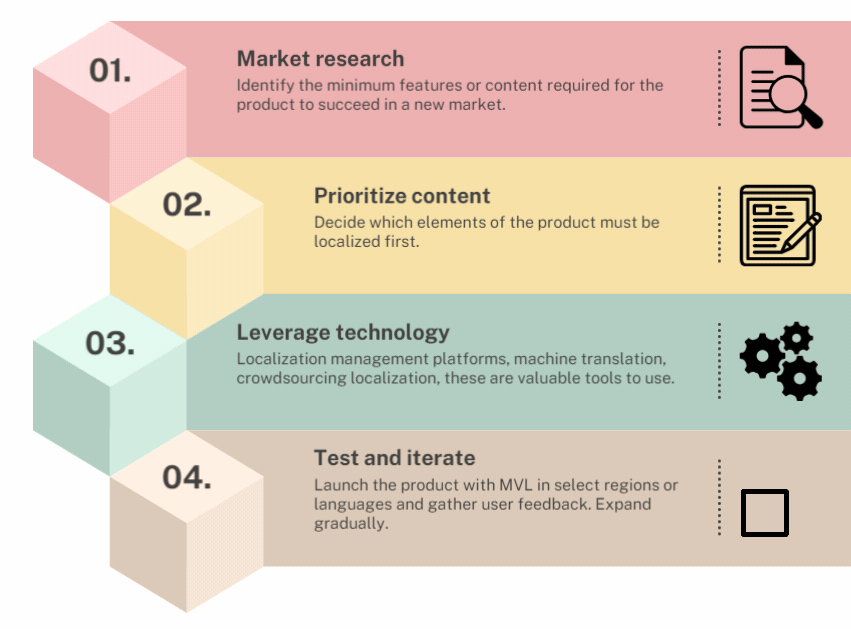
“Minimum Viable” is a common term used in the business world, often in relation to products, processes, and marketing. It refers to the simplest version of a concept that can be developed and released to provide value or gather feedback. In essence, it’s about starting small, learning quickly, and iterating effectively without over-investing upfront.
In localization, the term Minimum Viable Localization refers to a framework that focuses on delivering the most essential, minimal amount of localization necessary for a product or service to successfully enter a new market. MVL is similar in concept to the Minimum Viable Product (MVP) model in startups, where the goal is to test the market with a simplified version of a product.
The idea behind MVL
MVL helps deliver products/services that are understandable and usable in a new market with minimal effort and resources, rather than fully translating and localizing all content. It prioritizes essential content, which means companies can quickly validate market interest or enter new regions without investing too much initially.
The benefits it offers
First and foremost, MVL allows companies to expand into new markets quickly and cost-effectively. Since you would be focusing only on the essential elements needed to make a product functional in a new region, you can reduce the time and financial investment typically required for full localization.
This lean approach is particularly valuable for startups and companies with limited resources; they can test the waters in international markets before committing to broader localization. MVL helps validate market potential without the risk of overinvesting in a market that may not yet show strong demand.
Another advantage of MVL is its flexibility and scalability. The core aspects are localized first, which means you gather real-time feedback from users in new regions. This iterative process enables you to progressively enhance your localization as you gain more insight into the market. It also reduces the risk of misallocating resources since you’d be focusing on the areas where there is proven demand.
What gets localized
As mentioned, in Minimum Viable Localization, you’ll only be localizing the bare minimum. This often means elements like:
- User Interface (UI)
- Key functionality
- Support and help content
- Legal/compliance content
Improve your localization process
Discover an easy to use and affordable localization app.The primary focus is on translating the user interface (UI) elements that users interact with most frequently, such as menus, buttons, and basic navigation, allowing them to navigate the product without confusion. You need to provide users with a smooth experience while minimizing the time and resources invested in localization.
Core product features also receive attention in MVL. These are the functionalities that are critical for the user to engage with the product effectively. In a communication app, for examples, sending and receiving messages would be prioritized for localization, while less essential features might be left untranslated until there’s more market traction.
Legal and compliance-related content, such as terms and conditions and privacy policies, is another focus area, especially in regions with strict data protection laws or unique market regulations. Additionally, basic customer support content, such as frequently asked questions and essential help documents, are often localized to provide users with the support they need to get started.
How to implement MVL

Step 1: Do your (market) research
Implementing Minimum Viable Localization begins with thorough market research. You need to understand the specific cultural, linguistic, and legal requirements of the target market. By identifying what is essential for the product to function effectively, you can prioritize what is “minimally viable” for your business. Study user behavior, local regulations, and market conditions to determine which parts of the product must be adapted while keeping non-essential features in their original form.
Step 2: Choose the content that will be localized
Most often, businesses focus on the user interface (UI), key product features, and legal or compliance-related materials. You must decide what’s vital for users to navigate, understand, and engage when it comes to your product or service. Core functions, payment systems, and support documentation are usually top of the list. Your objective at the moment is to localize just enough to ensure usability while leaving less critical content for later, if needed.
Step 3: Invest in tools
To streamline the localization process, localization management platforms are great tools to utilize because they allow you to automate much of the translation process. You’d be reducing manual work and speeding up time to market. Such platforms help manage translation workflows, so that updates and changes to the product are efficiently localized without disrupting the development process.
Machine translation (MT) has come a long way since its inception, and while it may not provide perfect translations, it can be used for non-critical content. For companies where the localization budget is limited, MT helps them focus human resources on translating and localizing the most important customer-facing elements.
If you want to keep costs even lower, crowdsourcing localization is another technological approach you may want to consider, especially if your company has an active user base. It works by engaging users or local communities to contribute translations. Localization management platforms like POEditor offer this valuable feature.
Step 4: Gather feedback
After the initial localization is complete, it’s time to launch the product in the new market(s) and gather user feedback. This is where the iterative nature of MVL comes into play. You can use real-time feedback and performance data to determine what additional localization may be necessary. If the product gains traction… and you have the budget for full localization, you can progressively localize more content based on what your users find most valuable.
Some of the challenges that may arise
Minimum Viable Localization is all about minimalism, but how much of a minimalist can you be? Since MVL focuses on localizing only the most essential elements of a product, there’s a risk that users may encounter untranslated or poorly adapted content. This can negatively impact the user experience and give the impression of unprofessionalism.
Another challenge is the potential impact on brand perception. Say your competitors have fully localized products while your company is offering only a basic, partially localized version. That’s not a good look for your brand; it feels like you’re cutting corners. For some users, localization quality may influence their purchasing decision.
MVL is often just a first step. Over time, as the product gains traction, you may face pressure to expand localization. If your initial MVL approach is too minimal, you may have to revisit your localization strategy sooner than expected. Plan your approach carefully so that you have a clear path for gradual improvements.